Aila
- from Chat GPT 4o, 28 June 2025
- sources: Wikipedia – Ayla (city)
By the 4th century CE, Aila had developed into a walled city with a rectangular fortification plan. Archaeological excavations have uncovered city walls, gates, towers, a street grid, and residential and commercial buildings, some rebuilt after earthquake damage. Aila became a diocese in the Christian period and was later expanded under the Umayyads, who established a new Islamic city adjacent to the Roman‑Byzantine one. Its importance continued into the Abbasid and Fatimid periods, before declining with the emergence of competing trade hubs.
Today, the archaeological site of Aila lies within modern Aqaba. Excavations from the 1980s–2000s by the University of Chicago (notably under Donald Whitcomb and S. Thomas Parker) revealed deep stratigraphy with evidence of repeated seismic destruction and rebuilding phases. These findings shed light on the resilience and transformation of Red Sea port towns across nearly a millennium.
- from Aqaba/Elat - Introduction - click link to open new tab
- Fig. 2.15 - Location Map
for Aqaba and environs from Allison (2013)

 Figure 2.15
Figure 2.15
Map of archaeological sites in greater Aqaba, Jordan region (modified after Brückner et al. 2002).
Allison (2013) - Map showing location
of Islamic Ayla and Byzantine Aila (aka Ailana) from Whitcomb (1988)

 Map of the modern city of Aqaba with ancient and medieval archeological sites
Map of the modern city of Aqaba with ancient and medieval archeological sites
JW: Apparently Ailana = Aila
Whitcomb (1988) - Fig. 2 Map showing
location of Islamic Ayla and Byzantine Aila from Whitcomb (1997)
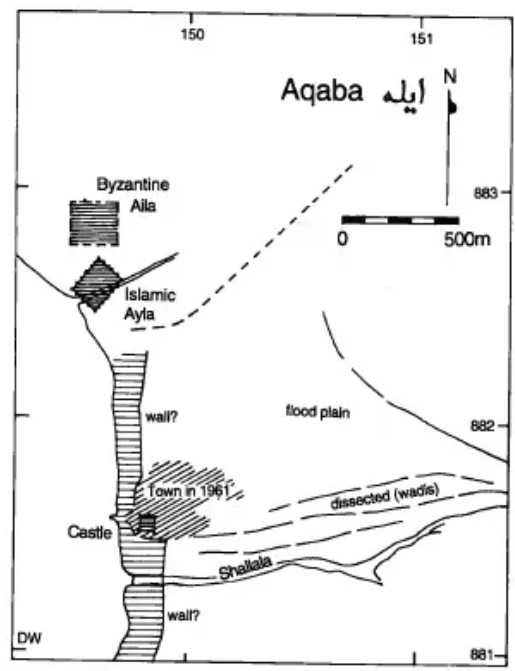
 Figure 2
Figure 2
The succession of settlements at 'Aqaba, Jordan
Whitcomb (1997) - Fig 2.8B Map showing
location of Area J-east from Niemi (2014)

 Fig. 2.8 B)
Fig. 2.8 B)
Map of Aqaba showing the three archaeological sites near the coast, some major roads, and location of cross faults and possible Aqaba fault strands.
Niemi (2014)
- Fig. 2.15 - Location Map
for Aqaba and environs from Allison (2013)

 Figure 2.15
Figure 2.15
Map of archaeological sites in greater Aqaba, Jordan region (modified after Brückner et al. 2002).
Allison (2013)
- Fig. 2.15 Plan of Area J-east
from Thomas et al (2007)

 Fig. 2.15
Fig. 2.15
Faults exposed in the Roman Aqaba Project excavation Area J-East
Niemi - Chapter 2 from Parker et al (2014) - Fig. 8 Map/Plan showing
location of Area B from Dolinka (2003:32)

 Fig. 8
Fig. 8
Plan of the areas excavated by the Roman Aqaba Project, after the 1998 season. Note that the location of Nabataean/Roman Aila is in the area not surveyed by Meloy (courtesy of RAP).
JW: Area B is in upper middle of map
Dolinka (2003)
- Fig. 2.15 Plan of Area J-east
from Thomas et al (2007)

 Fig. 2.15
Fig. 2.15
Faults exposed in the Roman Aqaba Project excavation Area J-East
Niemi - Chapter 2 from Parker et al (2014) - Fig. 8 Map/Plan showing
location of Area B from Dolinka (2003:32)

 Fig. 8
Fig. 8
Plan of the areas excavated by the Roman Aqaba Project, after the 1998 season. Note that the location of Nabataean/Roman Aila is in the area not surveyed by Meloy (courtesy of RAP).
JW: Area B is in upper middle of map
Dolinka (2003)
- Fig. 4
Section Walls 26 & 48 from Thomas et al (2007)

 Fig. 4
Fig. 4
Section drawing Wall 26 and Wall 48, showing earthquake damage and fault offsets.
Thomas et al (2007) - Fig. 5
Section C from Thomas et al (2007)

 Fig. 5
Fig. 5
. Stratigraphic sections of the south and north baulks of J-1, showing the faults.
Thomas et al (2007) - Fig. 5
Section A from Thomas et al (2007)

 Fig. 5
Fig. 5
. Stratigraphic sections of the south and north baulks of J-1, showing the faults.
Thomas et al (2007) - Fig. 5
Section B from Thomas et al (2007)

 Fig. 5
Fig. 5
. Stratigraphic sections of the south and north baulks of J-1, showing the faults.
Thomas et al (2007) - Fig. 6
Section N corner of Room 6 from Thomas et al (2007)

 Fig. 6
Fig. 6
Section drawing of the north corner of Room 6, showing the relationship between the earthquake damage ...
Thomas et al (2007) - Fig. 7
Section Blocked Archway N Wall Room 4 from Thomas et al (2007)

 Fig. 7
Fig. 7
Section drawing and photo of the blocked archway and slip on fractures in it in the north wall of Room 4
Thomas et al (2007) - Fig. 8
Section N Wall Room 11 from Thomas et al (2007)

 Fig. 8
Fig. 8
Section drawing of the plastered north wall of Room 11. The second phase of plastering probably repairs diagonal tension fractures developed from the earthquake at the end of Phase 2. The corner wall join also shows repair. The west wall is collapsed westward, perhaps in a much later earthquake.
Thomas et al (2007) - Fig. 9
Section S Wall Room 12 from Thomas et al (2007)

 Fig. 9
Fig. 9
Section drawing of the south wall of Room 12. This wall lies very close to the trend of the active fault that traverses the site. Several earthquake-induced structural damage features are noted, including a slump failure along the west wall, extensional and shear fractures, collapsed walls, and a wall join repair.
Thomas et al (2007) - Fig. 10
Section wall near the stairway and arch pillar in Room 4 from Thomas et al (2007)

 Fig. 10
Fig. 10
Section drawing of repairs in the wall near the stairway and arch pillar in Room 4. Most of the west wall is intact, standing to a height of ca. 2 m.
Thomas et al (2007) - Fig. 11
Section and photos of quake damage in Rooms 2 and 3 from Thomas et al (2007)

 Fig. 11
Fig. 11
Section drawing and photos of the earthquake damage in Rooms 2 and 3.
Thomas et al (2007) - Fig. 11
Section S wall Room 3 from Thomas et al (2007)

 Fig. 11
Fig. 11
Section drawing and photos of the earthquake damage in Rooms 2 and 3.
Thomas et al (2007) - Fig. 11
Section S wall Room 3 View W from Thomas et al (2007)

 Fig. 11
Fig. 11
Section drawing and photos of the earthquake damage in Rooms 2 and 3.
Thomas et al (2007) - Fig. 11
Photo of collapse of S wall Room 2 view W from Thomas et al (2007)
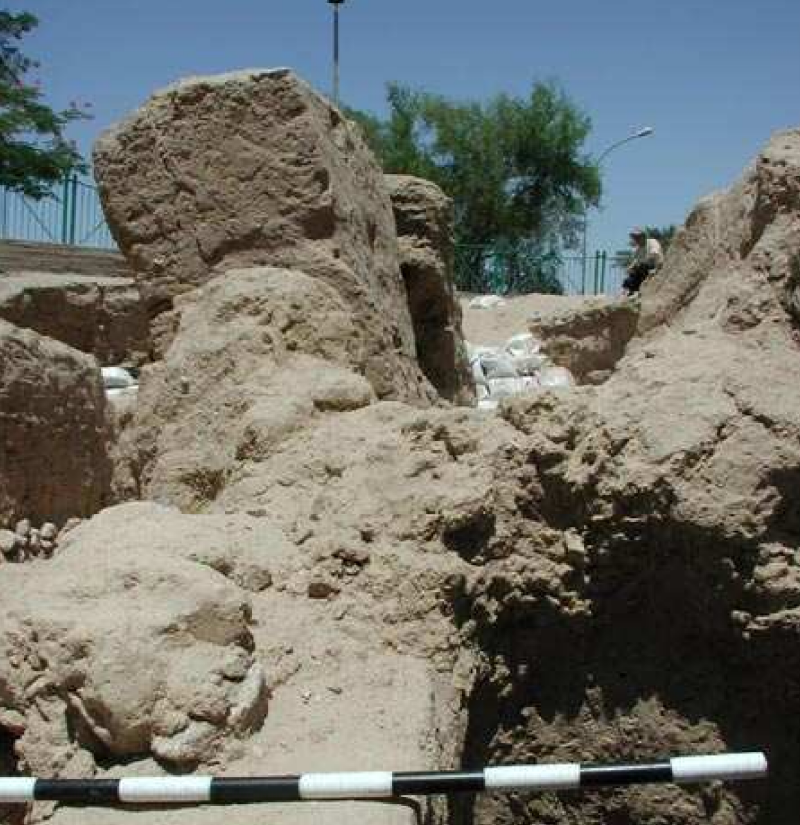
 Fig. 11
Fig. 11
Section drawing and photos of the earthquake damage in Rooms 2 and 3.
Thomas et al (2007) - Fig. 11
Photo of collapse of S wall Room 2 view W from Thomas et al (2007)

 Fig. 11
Fig. 11
Section drawing and photos of the earthquake damage in Rooms 2 and 3.
Thomas et al (2007)
- from Thomas et al (2007)
 Fig. 3
Fig. 3Schematic columnar stratigraphic section of the deposits at the J-East site, showing mudbrick tumble from earthquakes on floor levels, sand horizons, occupational levels, and earthquake event horizons.
Thomas et al (2007)
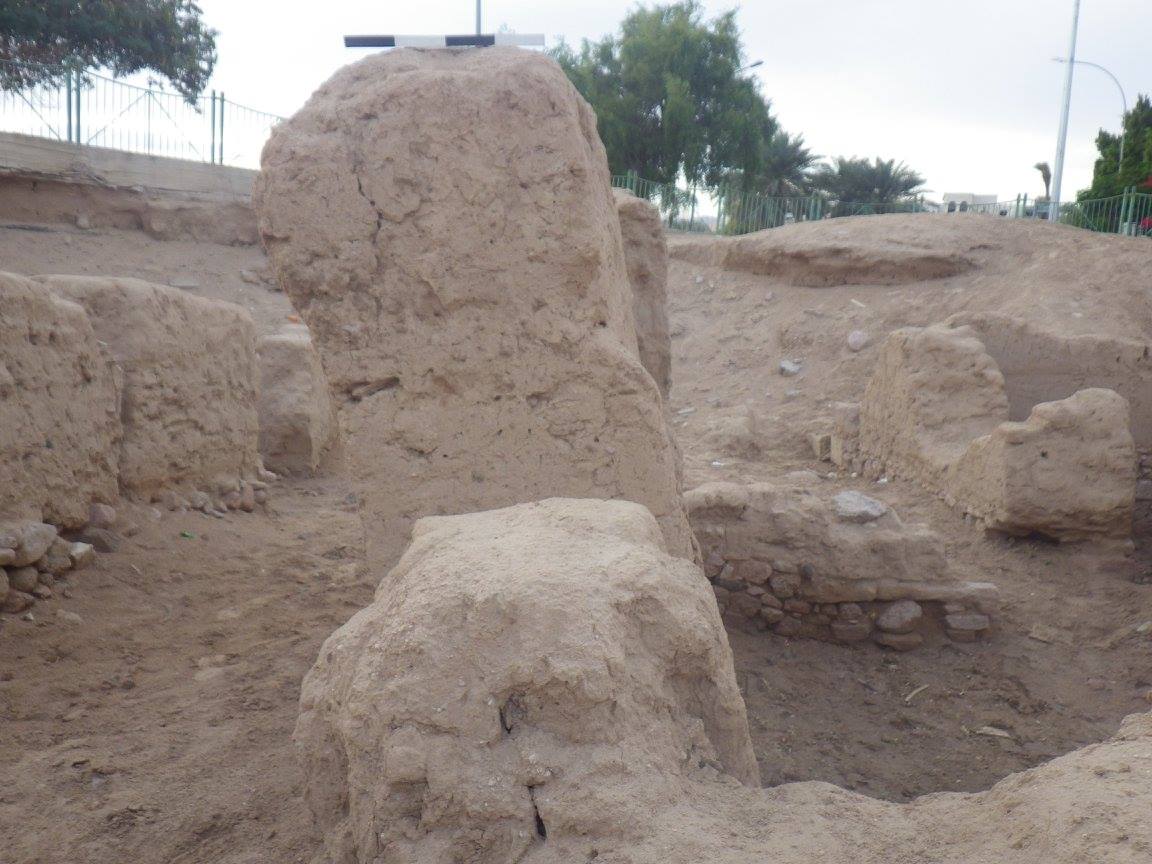
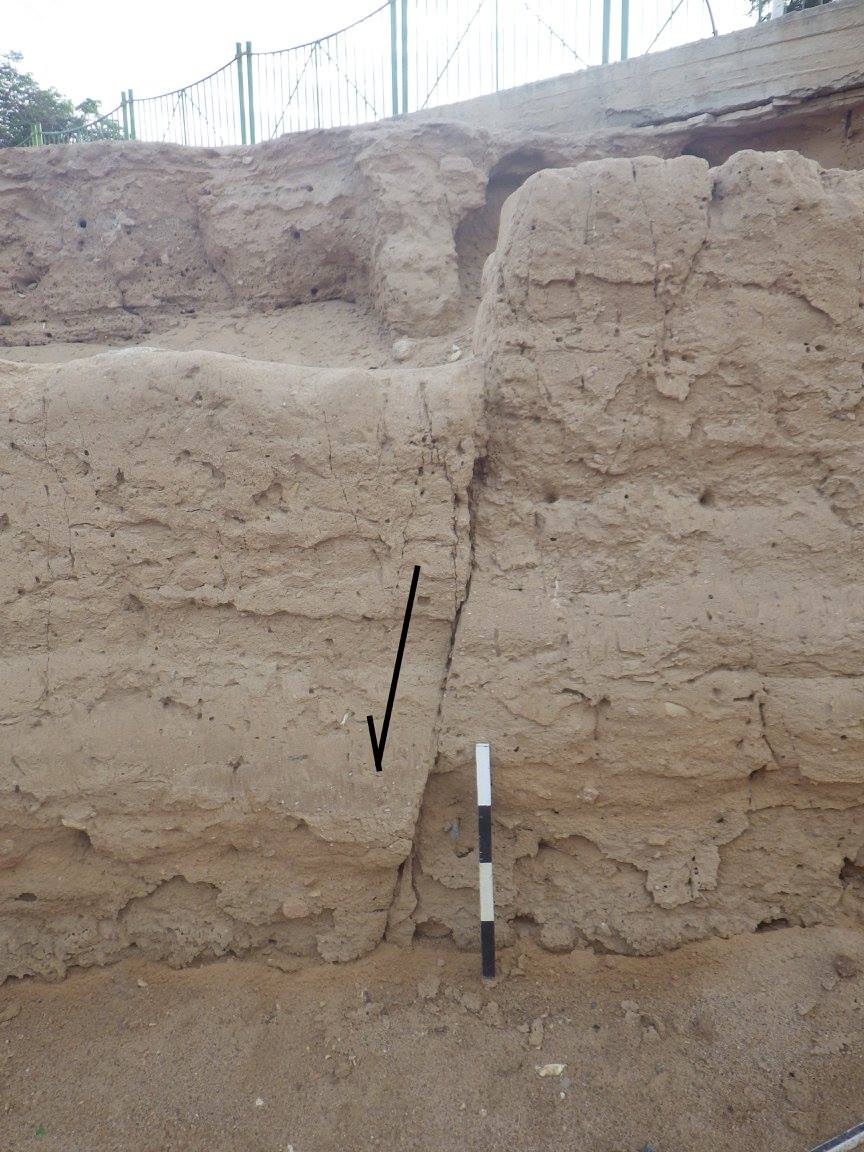 Left
LeftTilted South Wall of Room 2 at Aila J-East
Right
Normal Faulting of a wall at Aila J-East
photos by Jefferson Williams
-
Composite columnar stratigraphic section
for the deposits of the J-east site from Thomas et al (2007)

 Fig. 3
Fig. 3
Schematic columnar stratigraphic section of the deposits at the J-East site, showing mudbrick tumble from earthquakes on floor levels, sand horizons, occupational levels, and earthquake event horizons.
Thomas et al (2007)
- from Thomas et al (2007)
 Fig. 3
Fig. 3Schematic columnar stratigraphic section of the deposits at the J-East site, showing mudbrick tumble from earthquakes on floor levels, sand horizons, occupational levels, and earthquake event horizons.
Thomas et al (2007)
Thomas et al (2007) excavated and examined area J-east between 1994 and 2003.
The J-East area is a multiphase site incorporating Early Islamic to Byzantine domestic occupation and a late third to fourth-century monumental mudbrick structure that has been interpreted as a church (Parker 1998a; 1999a; Mussell 2001; Rose 1998; Weintraub 1999)( Thomas et al, 2007). This site, in the Roman-Byzantine town of Aila, is located ~500 m north of the modern shoreline of Aqaba and ~500 m NW of the Islamic town of Ayla . Thomas et al (2007) identified 6 or 7 earthquakes from the 2nd century CE onward in J-east and divided up the timing as shown the the table below.
- from Thomas et al (2007)
 Fig. 3
Fig. 3Schematic columnar stratigraphic section of the deposits at the J-East site, showing mudbrick tumble from earthquakes on floor levels, sand horizons, occupational levels, and earthquake event horizons.
Thomas et al (2007)
- from Thomas et al (2007)
 Fig. 3
Fig. 3Schematic columnar stratigraphic section of the deposits at the J-East site, showing mudbrick tumble from earthquakes on floor levels, sand horizons, occupational levels, and earthquake event horizons.
Thomas et al (2007)
- from Thomas et al (2007)
 Fig. 3
Fig. 3Schematic columnar stratigraphic section of the deposits at the J-East site, showing mudbrick tumble from earthquakes on floor levels, sand horizons, occupational levels, and earthquake event horizons.
Thomas et al (2007)
- from Thomas et al (2007)
 Fig. 3
Fig. 3Schematic columnar stratigraphic section of the deposits at the J-East site, showing mudbrick tumble from earthquakes on floor levels, sand horizons, occupational levels, and earthquake event horizons.
Thomas et al (2007)
- from Thomas et al (2007)
 Fig. 3
Fig. 3Schematic columnar stratigraphic section of the deposits at the J-East site, showing mudbrick tumble from earthquakes on floor levels, sand horizons, occupational levels, and earthquake event horizons.
Thomas et al (2007)
Thomas et al (2007) identified earthquake destruction (Earthquake V) in a collapse layer which they dated to the southern Cyril Quake. A terminus post quem of 360 CE for Earthquake V was established with coins and pottery.
Thin wall construction and surface layers produced pottery from the mid to late fourth century A.D. (similar types to Phase 2 described earlier). The latest pottery dates from about A.D. 360 onward (based on several examples of African Red Slip form 67, introduced ca. A.D. 360; Hayes 1972). However, over 100 coins were found on the final floor of this phase. The majority of these coins were found associated with the remains of a broken box in Room 2. The latest coins date to the reign of Constantius II who reigned from A.D. 337 to 361 (Parker 1999a) and provide a terminus post quem for this building phase.They added
The very refined pottery and coin dates give a secure post A.D. 360 date for the Earthquake V event. The scarcity of post A.D. 360 pottery and the location of the coin hoard at the interface between occupation surface and collapse horizon indicate that this event cannot have occurred long after A.D. 360. We have interpreted this earthquake to be the historically attested earthquake of May 19, A.D. 363 (Russell 1980; Guidoboni 1994: 264-67).Powers (2010) adds the following background information:
At the end of the troubled third century, the Legio X Fretensis was transferred from Jerusalem to bolster Diocletian’s new Limes Arabicus, to the effect that the population increased substantially and the city emerged as a regional centre.61 A church was built in c. 300 – one of the oldest in the world – testifying to the early progress of Christianity in Palestine; it was apparently destroyed by the earthquake of 363 and subsequently covered by the new city wall. This stone and mud-brick wall was complete by the late fourth or early fifth century, suggesting something of the seriousness which the continued threat of Saracen raiding was taken.62Footnotes61 Parker, 1996: 234, 253; 2000: 392. Eusebius, Onomasticon, 6.17-21 (1904).
62 Parker, 2003: 332.
- from Thomas et al (2007)
 Fig. 3
Fig. 3Schematic columnar stratigraphic section of the deposits at the J-East site, showing mudbrick tumble from earthquakes on floor levels, sand horizons, occupational levels, and earthquake event horizons.
Thomas et al (2007)
- from Thomas et al (2007)
 Fig. 3
Fig. 3Schematic columnar stratigraphic section of the deposits at the J-East site, showing mudbrick tumble from earthquakes on floor levels, sand horizons, occupational levels, and earthquake event horizons.
Thomas et al (2007)
| Effect | Location | Image (s) | Comments |
|---|---|---|---|
|
Faults F and H
 Fig. 2.15
Fig. 2.15Faults exposed in the Roman Aqaba Project excavation Area J-East Niemi - Chapter 2 from Parker et al (2014) |

 Fig. 5C
Fig. 5CStratigraphic sections of the south and north baulks of J-1, showing the faults. Thomas et al (2007) |
The youngest earthquake (Earthquake I) recorded at this site ruptured faults very close to the modern ground surface. ... Earthquake I ruptured Faults F and H. We measured a total displacement of 35 cm southwest dip-slip in figure 5C, with little or no apparent strike-slip. These faults trend more toward the west (N12°W and N34°W) than the fault rupture in previous earthquakes (ca. 10° more than II to III, and ca. 20° more than the Byzantine Earthquakes V to VI).- Thomas et al (2007) |
| Effect | Location | Image (s) | Comments |
|---|---|---|---|
|
Fault A and E and Wall J.1:26
 Fig. 2.15
Fig. 2.15Faults exposed in the Roman Aqaba Project excavation Area J-East Niemi - Chapter 2 from Parker et al (2014) |

 Fig. 5C
Fig. 5CStratigraphic sections of the south and north baulks of J-1, showing the faults. Thomas et al (2007) |
These deposits were ruptured and the buildings collapsed. Slip on Fault A produced a left-lateral strike-slip of 5 cm on Wall J.1:26, and Faults A and E caused an accumulated southwest dip-slip of 42 cm (measured in fig. 5C). Wall collapse was minor despite the obvious energy of the earthquake.- Thomas et al (2007) |
| Effect | Location | Image (s) | Comments |
|---|---|---|---|
|
Faults B, C, F, and G
 Fig. 2.15
Fig. 2.15Faults exposed in the Roman Aqaba Project excavation Area J-East Niemi - Chapter 2 from Parker et al (2014) |

 Fig. 5C
Fig. 5CStratigraphic sections of the south and north baulks of J-1, showing the faults. Thomas et al (2007) 
 Fig. 4
Fig. 4Section drawing of Wall 26 and Wall 48, showing earthquake damage and fault offsets. JW: may refer to Fault C Thomas et al (2007) |
|
| Effect | Location | Image (s) | Comments |
|---|---|---|---|
|
Fault D and Wall J.1.53
 Fig. 2.15
Fig. 2.15Faults exposed in the Roman Aqaba Project excavation Area J-East Niemi - Chapter 2 from Parker et al (2014) |

 Fig. 5C
Fig. 5CStratigraphic sections of the south and north baulks of J-1, showing the faults. Thomas et al (2007) |
Measured in Section C (fig. 5), Earthquake IV caused 12 cm of dip-slip across Fault D and up to 30 cm of lateral motion on Wall J.1.53. However, since Fault D also slipped in Earthquakes V and VI and appears to have caused more severe structural damage, strike-slip is probably minimal in this event. ... Earthquake IV probably caused the collapse of the long-abandoned domestic structures.- Thomas et al (2007) |
| Effect | Location | Image (s) | Comments |
|---|---|---|---|
|
Faults C and D, N Wall of Room 20, Wall J.1:53
 Fig. 2.15
Fig. 2.15Faults exposed in the Roman Aqaba Project excavation Area J-East Niemi - Chapter 2 from Parker et al (2014) |

 Fig. 4
Fig. 4Section drawing of Wall 26 and Wall 48, showing earthquake damage and fault offsets. Thomas et al (2007) 
 Fig. 5
Fig. 5Stratigraphic sections of the south and north baulks of J-1, showing the faults. Thomas et al (2007) |
The monumental building appears to have been violently shaken in Earthquake V. This is a more severe reactivation of Faults C and D but occurs along a slightly different rupture plane (through the Room 20 north wall - see Fig. 4) than during EQ VI. The amount of fault slip in this earthquake must exceed 23 cm of dip-slip (measured in sections A and B, fig. 5). Where Fault D shifted Wall J.1:53, a maximum of 30 cm of left-lateral strike-slip was measured. This slip is shared by reactivation in Earthquake IV and the previous Earthquake VI (discussed above). The collapse layer for Earthquake V exceeds 90 cm in places. The tumble is more evenly distributed throughout the site than was the case for the earlier Earthquake VI, with a bias to the north side of collapsing walls. This thick collapse horizon across the site suggests Earthquake V was stronger in intensity compared with Earthquake VI. The majority of the lateral slip across Fault D is likely to have occurred predominantly in Earthquake V (but also moves in Earthquakes VI and IV).- Thomas et al (2007) |
| Effect | Location | Image (s) | Comments |
|---|---|---|---|
|
various parts of J-east
 Fig. 2.15
Fig. 2.15Faults exposed in the Roman Aqaba Project excavation Area J-East Niemi - Chapter 2 from Parker et al (2014) |
The monumental mudbrick structure experienced fault rupture and collapse of some walls, producing a tumble horizon. The southern wall of Room 13 was ruptured by Fault D and the northern wall of Room 21 by Fault C. This tectonic shift caused substantial localized damage. Earthquake VI produced a total of 10 cm of left-lateral strike-slip measured across Fault C on Wall J.1:26, north of Room 21. This damage from the fault was repaired after Earthquake VI. The strike-slip of Fault D in EQ VI could not be measured because Fault D reactivated in subsequent Earthquakes V and IV. The total strike-slip measured along Wall J.1:53 is 30 cm. Since there was no repair to the wall, this suggests that the majority of the slip was caused by EQ VI. Similarly, the dip-slip could not be directly measured, but later releveling of the southwest corner of the monumental building indicates subsidence did occur. Elsewhere on the site, damage appears not to have been quite as severe, but seismically induced wall failures were repaired in the subsequent occupation phase.- Thomas et al (2007) |
| Effect | Location | Image (s) | Comments |
|---|---|---|---|
|
J-east

 Fig. 2.15
Fig. 2.15Faults exposed in the Roman Aqaba Project excavation Area J-East Niemi - Chapter 2 from Parker et al (2014) |
|
|
|
some structures in Area B
 Fig. 8
Fig. 8Plan of the areas excavated by the Roman Aqaba Project, after the 1998 season. Note that the location of Nabataean/Roman Aila is in the area not surveyed by Meloy (courtesy of RAP). JW: Area B is in upper middle of map Dolinka (2003) |

 Fig. 14
Fig. 14Tumbled-over mudbricks from the domestic complex in B.1/3 bear witness to the earthquake that ushered in the Abandonment II phase at Aila during the early-2nd century AD (courtesy of RAP) Dolinka (2003) |
|
- Modified by JW from Fig. 2 of Thomas et al (2007)
 Deformation Map
Deformation MapModified by JW from Fig. 2 of Thomas et al (2007)
- Modified by JW from Fig. 2 of Thomas et al (2007)
 Deformation Map
Deformation MapModified by JW from Fig. 2 of Thomas et al (2007)
- Modified by JW from Fig. 2 of Thomas et al (2007)
 Deformation Map
Deformation MapModified by JW from Fig. 2 of Thomas et al (2007)
- Modified by JW from Fig. 2 of Thomas et al (2007)
 Deformation Map
Deformation MapModified by JW from Fig. 2 of Thomas et al (2007)
- Modified by JW from Fig. 2 of Thomas et al (2007)
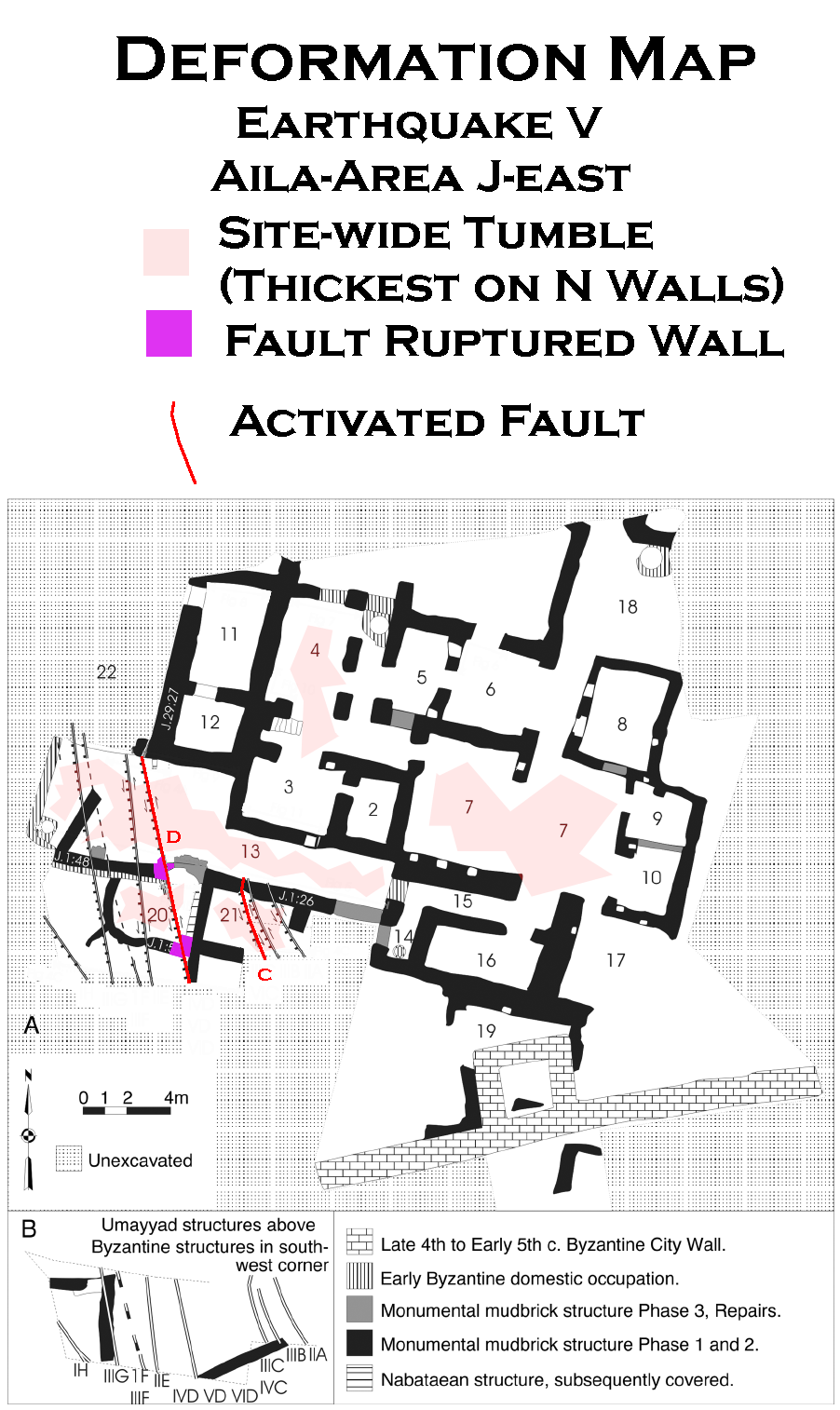 Deformation Map
Deformation MapModified by JW from Fig. 2 of Thomas et al (2007)
- Modified by JW from Fig. 2 of Thomas et al (2007)
 Deformation Map
Deformation MapModified by JW from Fig. 2 of Thomas et al (2007)
- Calculations made using calculators on this webpage
- Mcalpin (2009:312) suggests a minimum moment magnitude MW of 6.5 when on site rupture is observed
| Rupture Type | Min (cm) | Max (cm) | Average (cm) | MW min | MW max | MW avg |
|---|---|---|---|---|---|---|
| southwest dip-slip | 35 | 35 | 35 | 6.3 | 6.5 | 6.4 |
- Earthquake Archeological Effects chart
of Rodríguez-Pascua et al (2013: 221-224)
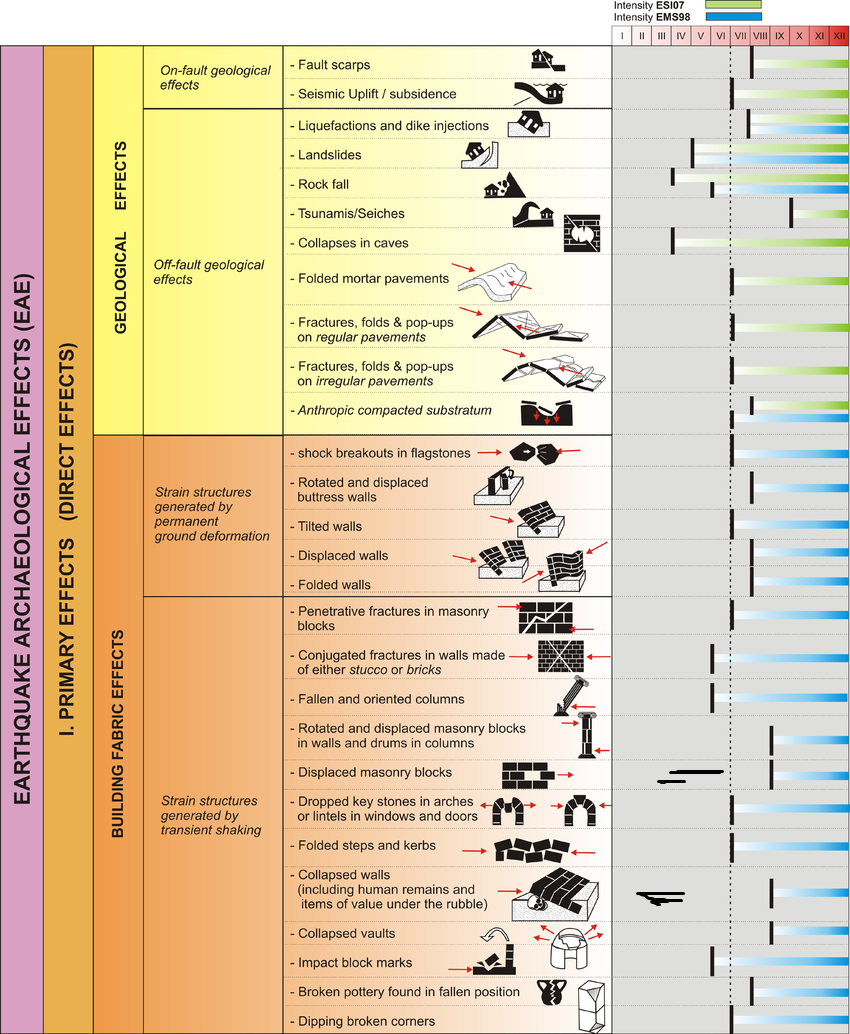
 Earthquake Archeological Effects (EAE)
Earthquake Archeological Effects (EAE)
Rodríguez-Pascua et al (2013: 221-224)
| Effect | Location | Image (s) | Comments | Intensity |
|---|---|---|---|---|
|
Faults F and H
 Fig. 2.15
Fig. 2.15Faults exposed in the Roman Aqaba Project excavation Area J-East Niemi - Chapter 2 from Parker et al (2014) |

 Fig. 5C
Fig. 5CStratigraphic sections of the south and north baulks of J-1, showing the faults. Thomas et al (2007) |
The youngest earthquake (Earthquake I) recorded at this site ruptured faults very close to the modern ground surface. ... Earthquake I ruptured Faults F and H. We measured a total displacement of 35 cm southwest dip-slip in figure 5C, with little or no apparent strike-slip. These faults trend more toward the west (N12°W and N34°W) than the fault rupture in previous earthquakes (ca. 10° more than II to III, and ca. 20° more than the Byzantine Earthquakes V to VI).- Thomas et al (2007) |
VI+ - VII+ |
- Calculations made using calculators on this webpage
- Mcalpin (2009:312) suggests a minimum moment magnitude MW of 6.5 when on site rupture is observed
| Rupture Type | Min (cm) | Max (cm) | Average (cm) | MW min | MW max | MW avg |
|---|---|---|---|---|---|---|
| left-lateral strike-slip | 5 | 5 | 5 | 5.8 | 5.9 | 5.85 |
| southwest dip-slip | 42 | 42 | 42 | 6.3 | 6.5 | 6.4 |
- Earthquake Archeological Effects chart
of Rodríguez-Pascua et al (2013: 221-224)

 Earthquake Archeological Effects (EAE)
Earthquake Archeological Effects (EAE)
Rodríguez-Pascua et al (2013: 221-224)
| Effect | Location | Image (s) | Comments | Intensity |
|---|---|---|---|---|
|
Fault A and E and Wall J.1:26
 Fig. 2.15
Fig. 2.15Faults exposed in the Roman Aqaba Project excavation Area J-East Niemi - Chapter 2 from Parker et al (2014) |

 Fig. 5C
Fig. 5CStratigraphic sections of the south and north baulks of J-1, showing the faults. Thomas et al (2007) |
These deposits were ruptured and the buildings collapsed. Slip on Fault A produced a left-lateral strike-slip of 5 cm on Wall J.1:26, and Faults A and E caused an accumulated southwest dip-slip of 42 cm (measured in fig. 5C). Wall collapse was minor despite the obvious energy of the earthquake.- Thomas et al (2007) |
VIII + |
- Calculations made using calculators on this webpage
- Mcalpin (2009:312) suggests a minimum moment magnitude MW of 6.5 when on site rupture is observed
| Rupture Type | Min (cm) | Max (cm) | Average (cm) | MW min | MW max | MW avg |
|---|---|---|---|---|---|---|
| left-lateral strike-slip | 4 | 4 | 4 | 5.7 | 5.8 | 5.75 |
| dip-slip | 54 | 54 | 54 | 6.4 | 6.6 | 6.5 |
- Earthquake Archeological Effects chart
of Rodríguez-Pascua et al (2013: 221-224)

 Earthquake Archeological Effects (EAE)
Earthquake Archeological Effects (EAE)
Rodríguez-Pascua et al (2013: 221-224)
| Effect | Location | Image (s) | Comments | Intensity |
|---|---|---|---|---|
|
Faults B, C, F, and G
 Fig. 2.15
Fig. 2.15Faults exposed in the Roman Aqaba Project excavation Area J-East Niemi - Chapter 2 from Parker et al (2014) |

 Fig. 5C
Fig. 5CStratigraphic sections of the south and north baulks of J-1, showing the faults. Thomas et al (2007) 
 Fig. 4
Fig. 4Section drawing of Wall 26 and Wall 48, showing earthquake damage and fault offsets. JW: may refer to Fault C Thomas et al (2007) |
|
VIII + |
- Calculations made using calculators on this webpage
- Mcalpin (2009:312) suggests a minimum moment magnitude MW of 6.5 when on site rupture is observed
| Rupture Type | Min (cm) | Max (cm) | Average (cm) | MW min | MW max | MW avg |
|---|---|---|---|---|---|---|
| strike-slip | 5 | 30 | 17.5 | 5.8 | 6.6 | 6.2 |
| dip-slip | 12 | 12 | 12 | 6.0 | 6.2 | 6.1 |
up to 30 cm of lateral motion on Wall J.1.53by Fault D,
since Fault D also slipped in Earthquakes V and VI and appears to have caused more severe structural damage, strike-slip is probably minimal in this event.
- Earthquake Archeological Effects chart
of Rodríguez-Pascua et al (2013: 221-224)

 Earthquake Archeological Effects (EAE)
Earthquake Archeological Effects (EAE)
Rodríguez-Pascua et al (2013: 221-224)
| Effect | Location | Image (s) | Comments | Intensity |
|---|---|---|---|---|
|
Fault D and Wall J.1.53
 Fig. 2.15
Fig. 2.15Faults exposed in the Roman Aqaba Project excavation Area J-East Niemi - Chapter 2 from Parker et al (2014) |

 Fig. 5C
Fig. 5CStratigraphic sections of the south and north baulks of J-1, showing the faults. Thomas et al (2007) |
Measured in Section C (fig. 5), Earthquake IV caused 12 cm of dip-slip across Fault D and up to 30 cm of lateral motion on Wall J.1.53. However, since Fault D also slipped in Earthquakes V and VI and appears to have caused more severe structural damage, strike-slip is probably minimal in this event. ... Earthquake IV probably caused the collapse of the long-abandoned domestic structures.- Thomas et al (2007) |
VIII + |
- Calculations made using calculators on this webpage
- Mcalpin (2009:312) suggests a minimum moment magnitude MW of 6.5 when on site rupture is observed
| Rupture Type | Min (cm) | Max (cm) | Average (cm) | MW min | MW max | MW avg |
|---|---|---|---|---|---|---|
| strike-slip | 20 | 30 | 25 | 6.3 | 6.6 | 6.45 |
| dip-slip | 23 | 54 | 38.5 | 6.2 | 6.6 | 6.4 |
- Earthquake Archeological Effects chart
of Rodríguez-Pascua et al (2013: 221-224)

 Earthquake Archeological Effects (EAE)
Earthquake Archeological Effects (EAE)
Rodríguez-Pascua et al (2013: 221-224)
| Effect | Location | Image (s) | Comments | Intensity |
|---|---|---|---|---|
|
Faults C and D, N Wall of Room 20, Wall J.1:53
 Fig. 2.15
Fig. 2.15Faults exposed in the Roman Aqaba Project excavation Area J-East Niemi - Chapter 2 from Parker et al (2014) |

 Fig. 4
Fig. 4Section drawing of Wall 26 and Wall 48, showing earthquake damage and fault offsets. Thomas et al (2007) 
 Fig. 5
Fig. 5Stratigraphic sections of the south and north baulks of J-1, showing the faults. Thomas et al (2007) |
The monumental building appears to have been violently shaken in Earthquake V. This is a more severe reactivation of Faults C and D but occurs along a slightly different rupture plane (through the Room 20 north wall - see Fig. 4) than during EQ VI. The amount of fault slip in this earthquake must exceed 23 cm of dip-slip (measured in sections A and B, fig. 5). Where Fault D shifted Wall J.1:53, a maximum of 30 cm of left-lateral strike-slip was measured. This slip is shared by reactivation in Earthquake IV and the previous Earthquake VI (discussed above). The collapse layer for Earthquake V exceeds 90 cm in places. The tumble is more evenly distributed throughout the site than was the case for the earlier Earthquake VI, with a bias to the north side of collapsing walls. This thick collapse horizon across the site suggests Earthquake V was stronger in intensity compared with Earthquake VI. The majority of the lateral slip across Fault D is likely to have occurred predominantly in Earthquake V (but also moves in Earthquakes VI and IV).- Thomas et al (2007) |
VIII + |
- Calculations made using calculators on this webpage
- Mcalpin (2009:312) suggests a minimum moment magnitude MW of 6.5 when on site rupture is observed
| Rupture Type | Min (cm) | Max (cm) | Average (cm) | MW min | MW max | MW avg |
|---|---|---|---|---|---|---|
| left-lateral strike-slip | 10 | 30 | 20 | 6.0 | 6.6 | 6.3 |
| dip-slip | ? | ? | ? | ? | ? | ? |
- Earthquake Archeological Effects chart
of Rodríguez-Pascua et al (2013: 221-224)

 Earthquake Archeological Effects (EAE)
Earthquake Archeological Effects (EAE)
Rodríguez-Pascua et al (2013: 221-224)
| Effect | Location | Image (s) | Comments | Intensity |
|---|---|---|---|---|
|
various parts of J-east
 Fig. 2.15
Fig. 2.15Faults exposed in the Roman Aqaba Project excavation Area J-East Niemi - Chapter 2 from Parker et al (2014) |
The monumental mudbrick structure experienced fault rupture and collapse of some walls, producing a tumble horizon. The southern wall of Room 13 was ruptured by Fault D and the northern wall of Room 21 by Fault C. This tectonic shift caused substantial localized damage. Earthquake VI produced a total of 10 cm of left-lateral strike-slip measured across Fault C on Wall J.1:26, north of Room 21. This damage from the fault was repaired after Earthquake VI. The strike-slip of Fault D in EQ VI could not be measured because Fault D reactivated in subsequent Earthquakes V and IV. The total strike-slip measured along Wall J.1:53 is 30 cm. Since there was no repair to the wall, this suggests that the majority of the slip was caused by EQ VI. Similarly, the dip-slip could not be directly measured, but later releveling of the southwest corner of the monumental building indicates subsidence did occur. Elsewhere on the site, damage appears not to have been quite as severe, but seismically induced wall failures were repaired in the subsequent occupation phase.- Thomas et al (2007) |
VIII + |
- Earthquake Archeological Effects chart
of Rodríguez-Pascua et al (2013: 221-224)

 Earthquake Archeological Effects (EAE)
Earthquake Archeological Effects (EAE)
Rodríguez-Pascua et al (2013: 221-224)
| Effect | Location | Image (s) | Comments | Intensity |
|---|---|---|---|---|
|
J-east

 Fig. 2.15
Fig. 2.15Faults exposed in the Roman Aqaba Project excavation Area J-East Niemi - Chapter 2 from Parker et al (2014) |
|
VIII + | |
|
some structures in Area B
 Fig. 8
Fig. 8Plan of the areas excavated by the Roman Aqaba Project, after the 1998 season. Note that the location of Nabataean/Roman Aila is in the area not surveyed by Meloy (courtesy of RAP). JW: Area B is in upper middle of map Dolinka (2003) |

 Fig. 14
Fig. 14Tumbled-over mudbricks from the domestic complex in B.1/3 bear witness to the earthquake that ushered in the Abandonment II phase at Aila during the early-2nd century AD (courtesy of RAP) Dolinka (2003) |
|
VIII + |
Source - Wells and Coppersmith (1994)
| Variable | Input | Units | Notes |
|---|---|---|---|
| cm. | |||
| cm. | |||
| m/s | Enter a value of 655 for no site effect Equation comes from Darvasi and Agnon (2019) |
||
| Variable | Output - not considering a Site Effect | Units | Notes |
| unitless | Moment Magnitude for Avg. Displacement | ||
| unitless | Moment Magnitude for Max. Displacement | ||
| Variable | Output - Site Effect Removal | Units | Notes |
| unitless | Reduce Intensity Estimate by this amount to get a pre-amplification value of Intensity |
Source -
Wells and Coppersmith (1994)
| Variable | Input | Units | Notes |
|---|---|---|---|
| cm. | Strike-Slip displacement | ||
| cm. | Strike-Slip displacement | ||
| Variable | Output - not considering a Site Effect | Units | Notes |
| unitless | Moment Magnitude for Avg. Displacement | ||
| unitless | Moment Magnitude for Max. Displacement |
The value given for Intensity with site effect removed is how much you should subtract from your Intensity estimate to obtain a pre-amplification value for Intensity. For example if the output is 0.5 and you estimated an Intensity of 8, your pre-amplification Intensity is now 7.5. An Intensity estimate with the site effect removed is helpful in producing an Intensity Map that will do a better job of "triangulating" the epicentral area. If you enter a VS30 greater than 655 m/s you will get a positive number, indicating that the site amplifies seismic energy. If you enter a VS30 less than 655 m/s you will get a negative number, indicating that the site attenuates seismic energy rather than amplifying it. Intensity Reduction (Ireduction) is calculated based on Equation 6 from Darvasi and Agnon (2019).
VS30 is the average seismic shear-wave velocity from the surface to a depth of 30 meters at earthquake frequencies (below ~5 Hz.). Darvasi and Agnon (2019) estimated VS30 for a number of sites in Israel. If you get VS30 from a well log, you will need to correct for intrinsic dispersion. There is a seperate geometric dispersion correction usually applied when processing the waveforms however geometric dispersion corrections are typically applied to a borehole Flexural mode generated from a Dipole source and for Dipole sources propagating in the first 30 meters of soft sediments, modal composition is typically dominated by the Stoneley wave. Shear from Stoneley estimates are approximate at best. This is a subject not well understood and widely ignored by the Geotechnical community and/or Civil Engineers but understood by a few specialists in borehole acoustics. Other considerations will apply if you get VS30 value from a cross well survey or a shallow seismic survey where the primary consideration is converting shear slowness from survey frequency to Earthquake frequency. There are also ways to estimate shear slowness from SPT & CPT tests.
Dolinka, B. J. (2003). Nabataean Aila (Aqaba, Jordan) from a Ceramic Perspective
Local and intra-regional trade in Aqaba Ware during the first and second centuries AD. Evidence from the Roman Aqaba Project.
Niemi, T. M. (2014). Chapter 2. The Regional Environment: in The Roman Aqaba Project Final Report volume 1: The Regional Environment and the Regional Survey Archaeological Reports 19.
S. T. Parker et al, III (eds). Boston, MA, American School of Oriental Research. 1: 33-80.
Parker, S.T. 1986. Romans and Saracens: A History of the Arabian Frontier. Winona Lake.
Parker, S.T. 1987a. Peasants, Pastoralists and Pax Romana: A Different View. Bulletin of
the American Schools of Oriental Research 265: 35-51.
Parker, S.T. 1996. The Roman ʿAqaba Project: the 1994 Campaign. Annual of the
Department of Antiquities of Jordan 40: 231-57.
Parker, S.T. 1997. Preliminary Report on the 1994 Season of the Roman Aqaba Project.
Bulletin of the American Schools of Oriental Research 305: 19-44.Parker, S.T. 1998. The Roman ʿAqaba Project: the 1996 Campaign. Annual of the
Department of Antiquities of Jordan 42: 375-94.
Parker, S.T. 1999. Brief Notice on a possible Fourth-Century Church at Aqaba, Jordan.
Journal of Roman Archaeology 12: 372–376.
Parker, S.T. 2000. The Roman ʿAqaba Project: the 1997 and 1998 Campaigns. Annual of
the Department of Antiquities of Jordan 44: 373-94.
Parker, S.T. 2002. The Roman ʿAqaba Project: the 2000 Campaign. Annual of the
Department of Antiquities of Jordan 46: 409-28.
Parker, S.T. 2003. The Roman ʿAqaba Project: the 2002 Campaign. Annual of the
Department of Antiquities of Jordan 47: 321-33.
Parker, S.T. 2006. Roman Aila and the Wadi Arabah: An Economic Relationship. In P.
Bienkowski & K. Galor (eds.) Crossing the Rift. Resources, Routes, Settlement
Patterns and Interaction in the Wadi Arabah. Oxford. pp. 223-230.
Parker, S.T. 2009. The Roman Port of Aila: Economic Connections with the Red Sea
Littoral. In L. Blue, J. Cooper, R. Thomas & J. Whitewright (eds.) Connected
Hinterlands. Proceedings of the Red Sea Project IV. Held at the University of
Southampton, September 2008. Oxford. pp. 79-84
Power, T. (2010). The Red Sea during the 'Long' Late Antiquity, AD 500-1000. Faculty of Oriental Studies. Oxford, University of Oxford. PhD.: 578.
Thomas, et al. (2007). "Structural damage from earthquakes in the second-ninth centuries at the archaeological site of Aila in Aqaba, Jordan: PERA." Bull Am Sch Orient Res 346: 59-77.
